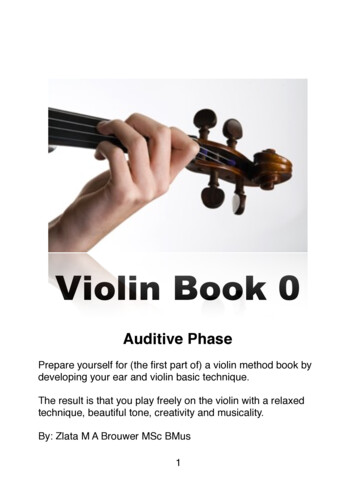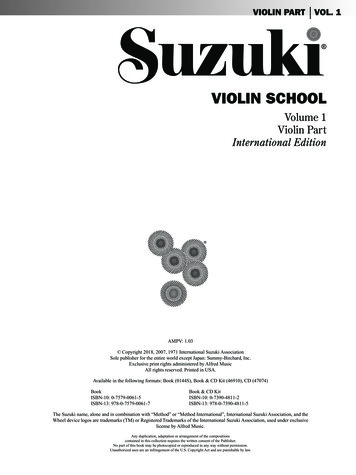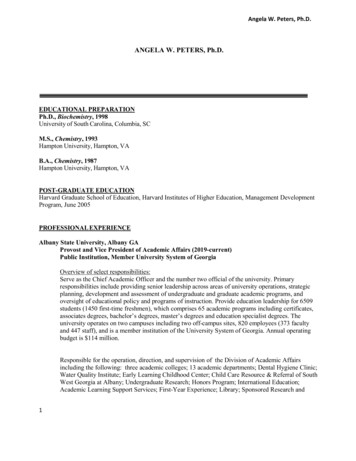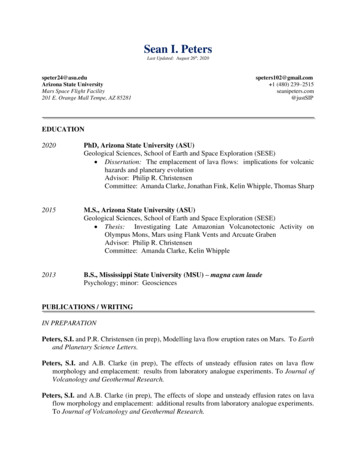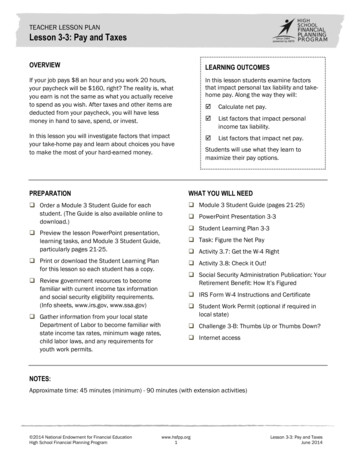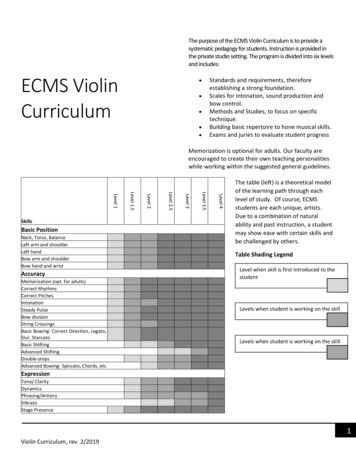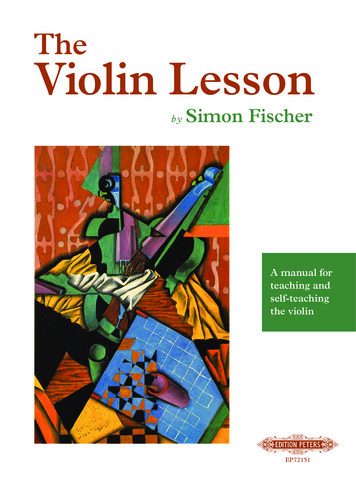
Transcription
TheViolin LessonbySimon FischerA manual forteaching andself-teachingthe violinEP 72151
ContentsDetailed contents . ivIntroduction. xvGeneral index. 334Index of musical examples . 342lesson 1The toneproduction lesson . 1lesson 2Holding theviolin and bow . 27lesson 3The intonationlesson . 55lesson 4Backgroundessentials 1 . 93lesson 5Setting up thebow arm . 117lesson 6Setting upthe left hand. 133lesson 7Avoiding achesand pains . 163lesson 8Backgroundessentials 2 . 205lesson 9All aboutchanging position . 231lesson 10The vibratolesson . 249lesson 11Improving keybow strokes . 261lesson 12Backgroundessentials 3 . 301
IntroductionThe idea for The Violin Lesson came one Christmas after going to a concert performance of Puccini’sMadame Butterfly in London. I was sitting quite near to the front and could not help noticing a violinist inthe orchestra who was directly in my line of vision, a woman in her early twenties. At first, I thought shewas a former student of mine. I later found out that the two women are often mistaken for each other inthe London orchestral scene.I could see in detail how she was playing. The way she was holding the violin, and using the bow, wasclearly making things more difficult for her than necessary. I thought of how easy it would be to help her,perhaps because I had seen her ‘twin’ become a much better player by making the same changes that thiswoman could make.It seemed sad that all she needed was one or two lessons in which to learn some simple things that she hadmissed so far – not the whole story of violin playing, from beginning to end, but a few important pointsand basic principles that would help her greatly.It would take only a couple of minutes to explain how everything was a question of getting the rightproportions (The magic word, page 96), and that she should hold the violin a little more in front of herbecause of her short arms; or how, if she kept her left fingers closer to the strings her finger action wouldbe easier.Her bow was constantly too near the fingerboard. I thought of how quickly she could improve her soundand feel for the instrument if she practised the Five essential tone-production exercises (page 11). Theytake only seconds to demonstrate, almost anybody can do them at once whatever their standard, and theimprovement in tone is always immediate.Yet I had no way of helping her; and solving her problems would not help the many other violinistsaround the world who were in exactly the same position as her – one or two really quite simple steps awayfrom a very different experience of playing the violin.The answer seemed clear: if she needed to know only a few basic things, and if just a few lessons would beenough, it should be possible to jot the basic ideas down on only a few sheets of paper. Then she wouldbe able to go away and sort it all out for herself in her own time.The subjects in the first few chapters of the book immediately fell into a logical order. However, what if thesame player returned for another series of lessons? What would the typical subjects be then? What if theycame for a whole course of 12 lessons?The division of The Violin Lesson into 12 is naturally only a starting-point. Working with an advancedstudent, and in a session that lasts a couple of hours, it is possible to cover much of the material of each‘lesson’ in a single session. Working with less advanced students, a single point from one of the lessons, orfrom the Background essentials, may be all that is covered in one actual violin lesson.The science of violin playingTo develop technique on the violin you have to learn the Science of Violin Playing. But this must notbe confused with studying ‘real’ sciences like physics, chemistry, biology, DNA and so on. Any field likethese is obviously a lifetime’s work, and however much you know is only ever a tiny speck compared tothe amount you do not know – even if you study all day, every day, for 50 years. In comparison, the entirescience of violin playing is only the size of a tiny speck.You cannot study for the rest of your life how to draw a straight bow; or study how to raise and drop thefingers, how to shift, vibrate and so on. There simply isn’t that much to learn. You can study music forthe rest of your life – and after fifty years, the amount you know about music will be only a tiny speckcompared to what you do not know – but that is a different matter.Introductionxv
On a practical, physical level of violin technique, there is not so much to know about. There are all thethings you have got to learn to do; and all the things to learn not to do. Yet all this amounts to only a fewprinciples about how to hold the instrument and bow, how to use each hand in all the various ways, andso on. The list of ‘things you need to know and do’ is not endless, and is not even very long.The Violin Lesson covers the main areas where you can easily and noticeably make a difference. Whilenot every subject is for everyone, The Violin Lesson has something in it for every level and type ofplayer – elementary or advanced, amateur or professional, teacher or student.Can you improve your playing by reading a book?No book can replace a teacher or the living, practical experience of playing or listening to music. Butgaining information from a book, or gaining that information through having somebody listen to you playand then saying those same things to you, can often be the same thing in the end.If you want to change the way you play the violin, you have to change the way you think about playingthe violin. You can do that by practising or by going to a concert, and by many other means; but readingabout, say, tone production, can so change your picture of bowing the string that your whole approachchanges immediately and dramatically – even before you have actually put the bow on the string andstarted to try things out.QBut the points in a book can only be general ones. In a lesson the teacher deals with Everyone has their own unique set of physical, technical and musical characteristics, theirown particular gifts, problems, strengths and weaknesses; yet the same technical and musicalpoints tend to appear again and again, and in the same way, in most players. Typical technical points in the left arm include freeing the thumb; moving the fingers freelyfrom the base joints, without partly moving them from the hand or forearm; widening thehand at the base joints, rather than contracting; fingers remaining light without overpressing; co-ordination, and the fundamentals of vibrato, intonation, shifting and so on. Typical technical points in the right arm include the basics of how to make a pure andexpressive tone; fundamentals of the bow hold; the mechanics of drawing a straight bow;how to improve key strokes like spiccato or martelé, and so on.There are actually quite a limited number of technical problems that you can have, and theytend to crop up in the same ways all the time. So the topics and issues that are explored in TheViolin Lesson may easily be exactly those that you need to explore yourself.Suppose your left hand does not feel comfortable. You do not necessarily need someone tolook at what you, specifically, are doing, and make suggestions that are tailored only to you.The same principles are going to apply to you as to anyone else.Building a good left hand position, or strengthening intonation, or developing tone or vibrato,or gaining confidence in shifting, is almost entirely the same process whoever you are, andwhatever your age or standard.I’m too old – you can’t improve at my ageIt used to be said that unless you had fully developed your violin technique by the time you were twentyor so, it would be too late. After that, the entire process of learning becomes slow and difficult, it wasthought, and you stand little chance of making further progress.Johann Quantz expressed this in 1752:1Johann Joachim Quantz:Essay of a Method forPlaying the TransverseFlute (Berlin 1752; trans.Edward R. Reilly, London,1966), 24.2See The magic word,page 96xviHe who wishes to distinguish himself in music must not begin the study of it too late. If he sets about it at an age when hisenergies are no longer vigorous, or when his throat or fingers are no longer flexible, and thus cannot acquire sufficientfacility to perform the passage-work roundly and distinctly, he will not go very far.1The truth is that you can improve your playing at any age. ‘Improving’ means changing the way you playEverything in violin technique can be described, and the language used to describe it is all aboutproportions: how much of this, in proportion to how much of that.2Introduction
To change the way you play, first you must know what all the different things are that can be measuredin proportion to one another. (It is no use knowing only that the recipe for a cake is made up of certainproportions. You need to know what the ingredients are in the first place.)Then, making every change by altering the proportions of one thing to another, you can build changesinto your playing at any age whatsoever.Q To change from banging fingers down onto the string and then pressing the string hard intothe fingerboard, and instead to place the fingers gently and to feel the springiness of thestring, is something you can introduce into your playing at any age and immediately noticethe difference. At any age and stage, you can change from playing everything with the bow too near tothe fingerboard, to playing a little nearer to the bridge where the string has greater tension Or find a new feeling of release and lightness in the left hand by stopping squeezing theneck hard between the fingers and thumb Orstart to encourage a feeling of forward–forward–forward–forward in the vibratomovement instead of forward–back–forward–back Or refine your intonation by tuning all your Gs, Ds, As and Es to the open strings, andby measuring all the sharps from the natural above, and the flats from the natural below Or stop extra, unnecessary physical motions that get in the way of everything else; andso on.All of these changes are perfectly easy to make, and anyone can make them. There is nospecial aptitude or talent required to feel such things as the difference between the give of thebow at the heel and at the point; or to feel how you can balance the bow in your hand (whenappropriate) rather than hold it; or to experiment with a new arrangement of the fingers onthe bow; or to do anything else.You simply need to know exactly what you are doing; what to do and what not to do; makesimple changes; and then continue in the new way until the changes become new habitsand ‘stick’ without your having to think about them. In just a few lessons or a few days, anadult violinist – amateur, student or professional – can change their playing as much as anunfocused child may do in months or years.QBut don’t children Obviously, young children can learn a foreign language without even noticing; their musclesare marvellously soft and responsive; every stage of their learning traces a brand-new path,without conflicts or confusions with previous paths; learning takes place on the deepest levelof the psyche, rather than having first to be processed by the intellect.It is common for a 10-year-old to be able to master difficult virtuosic pieces after playing forfive years or less, but not so common for an adult who has taken up the violin at a late age.Yet in a lot of ways, as an adult, you can learn and improve your playing just as quickly as achild, and in many cases much faster. You are able to measure, which is a skill young childrendevelop only gradually. You have the benefit of the general life experience that the child hasnot had, so you can make connections that they cannot make; and you have the powers ofreason, self-motivation and will.You can be clear about where you are now, clear about where you want to be in the future, andtake steps to move from here to there.1Not just trying harderSimply trying harder often makes things worse. Everything is a matter of cause and effect, which meansthat for every specific action there is a specific reaction. If you carry on performing the same actions, youcan expect to keep getting the same reactions or results.In other words, if you carry on doing what you are already doing, you just get more of what you arealready getting. Then, if you try harder, you just get even more of what you are already getting. Instead,the answer is always to change something. The slightest change in what you are doing, or how you aredoing it, will always bring about a completely new result.1Albert Einstein said: is to do the same thing inthe same way, over andover again, and expect a commonly used in business: “Do not work ! See alsoThe importance of makingmistakes, page 333Introductionxvii
1See Which part of the , page 253For example, the tiniest change in the exact area of the fingertip that contacts the string, changes thecharacter of the vibrato. Instead of continuing to put the finger down on the string on the same part ofthe fingertip each time, and trying harder to make different colours, all you have to do is put the fingerdown a little flatter (Fig. 1a), or a little more upright (Fig. 1b).1Fig. 1(a) Vibrating more on the pad(b) Vibrating mo
Violin Lesson may easily be exactly those that you need to explore yourself. Suppose your left hand does not feel comfortable. You do not necessarily need someone to look at what you, specifically, are doing, and make suggestions that are tailored only to you. The same principles are going to apply to you as to anyone else. Building a good left hand position, or strengthening intonation, or .
